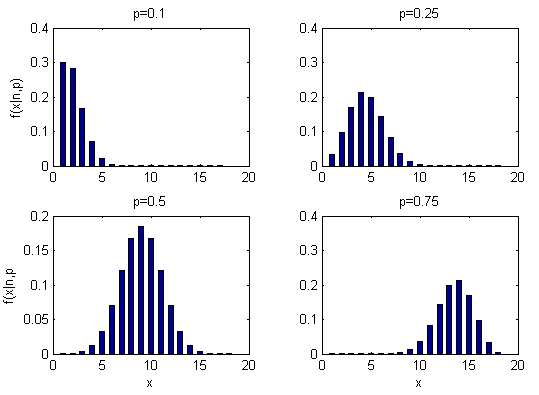Binomial Test
Table of contents
Binomial Distribution
Binomial distribution is a discrete probability distribution that describes the probability of a success in a binomial (yes-no) experiment.
Each binomial experiment is also called a Bernoulli trial:
- Each trial has binary outcome: success or failure
- Each trial is independent of each other
- The probability of success is the same for each trial, denoted as $p$
- The number of trials is fixed, denoted as $n$
When probability of success $p$ is:
- $p = 0.5$, the distribution is symmetric
- $p < 0.5$, the distribution is skewed to the left
- $p > 0.5$, the distribution is skewed to the right
Probability Mass Function
Let $X$ be the random variable that represents the number of successes in $n$ trials, and $p$ be the probability of success in each trial.
Then, the probability mass function of $X$ is:
$$ Pr\left[X = k\right] = \binom{n}{k} p^k (1-p)^{n-k} $$
Binomial Coefficient
\[\binom{n}{k} = \frac{n!}{k!(n-k)!}\]where $k$ is the number of successes in $n$ trials.
Then we say that $X$ follows a binomial distribution with parameters $n$ and $p$:
$$ X \sim \text{Binomial}(n, p) $$
Sum of Binomial Random Variables
If $X_1 \sim \text{Binomial}(n_1, p)$ and $X_2 \sim \text{Binomial}(n_2, p)$,
$$ X_1 + X_2 \sim \text{Binomial}(n_1 + n_2, p) $$
Hypothesis Test
Null Hypothesis
Let $P$ be the probability of success in a binomial experiment.
Supose we were testing whether a coin is fair or not.
Then, the null hypothesis would be:
$$ H_0: P = 0.5 $$
Meaning the chances of getting heads or tails are equal.
Calculating the p-value
When the null hypothesis is true, we can plug in $P = 0.5$ into the probability mass function:
\[Pr\left[X = k\right] = \binom{n}{k} 0.5^n\]Suppose our sample had 21 heads out of 30 trials.
Now we want to calculate our p-value which is the probability of observing an outcome as extreme as the one we observed, in a binomial distribution with $n = 30$ and $p = 0.5$.
The probability of this extreme case is the sum of the probabilities of getting 21 or more heads or 9 or less heads:
\[Pr\left[X \geq 21\right] + Pr\left[X \leq 9\right] = \sum_{k=21}^{30} \binom{30}{k} 0.5^{30} + \sum_{k=0}^{9} \binom{30}{k} 0.5^{30} \approx 0.043\]Remember, with two-tailed test, we need to take both extremes into account.
Based on the results, we can reject the null hypothesis as $0.043 < 0.05$.
